Storage space in your iPhone or iPad can quickly fill up depending on the storage capacity you bought and the content that you have on your device. When you start running short on space, or you see the error message that your device’s storage is full, don’t worry, you can start following these tips on how to free up storage. iPhones and iPads don’t offer expandable storage and the following tricks should do the trick.
Here are some tips to help you free up space on your iPhone or iPad device.
1. Offload or Delete Unused Apps
Our iPhones and iPads have been with us for years. And sometimes there might be some apps that have been in our devices and we have not been using them. These apps can sometimes be unexpected storage hogs.
There is an easy way to check on your storage to see which apps are taking up much of your precious storage space, and also see when you’ve last used the apps. You can open the Settings app then go to General > Usage > Manage Storage.
At the top, you’ll see how much space you have used and how much is still available. It then list the apps ranked by how much space they are using.
If you find that you still need the data on the app, you may choose to offload the apps and iOS automatically uninstalls the app but preserves the document and data so that when you reinstall the apps, all the data on the app will automatically restore.
You may also have some old games hidden on your phone that you’ve either finished or don’t play anymore. You can go ahead and delete them on this page. The beauty of the AppStore is that if after a few years you decided that you like to play that game back, you’ll still be able to download the games you’ve purchased just as long as it is still available on the AppStore.
2. Delete Videos on your iPhone or iPad
Videos are another storage hogs. In the world of 4K and HDR, videos downloaded from popular streaming services to be watched online can easily go to a few gigabytes of data. If you regularly download Netflix or Apple TV+ videos to your iPhone or iPad, this can quickly take up a lot of storage. You can quickly free up space by managing the number of videos stored on your device.
- Launch the Settings app on your iOS device.
- Tap General.
- Tap iPhone/iPad Storage.
- Tap Review Downloaded Videos.
- To delete a video from your device, swipe leftwards across the video you want to delete in the list, then tap the delete button. You may also tap Edit in the top right corner of the screen, then select the videos you want to remove, then click Done.
The recommendation to delete downloaded videos will only show up if you have videos downloaded on your device from apps like Netflix, Apple TV+, Prime Video, HBO Go, Disney Plus, Fitness+ and other sources.
3. Delete Downloaded Music
The playlist and albums that you downloaded to listen offline during the long flight or commute can start to add up. If you use Apple Music, it’s easy to find and delete your downloaded songs. Go to Settings > Music > Downloaded Music for a list of songs that are in your device. You can swipe to delete individual songs or you can swipe on All Songs a the top to delete all.
Also, in the music settings, iOS 14 introduced a new feature for iPhone, iPads and Apple Watch that can automatically download music to your device based on your available storage space. Just go to Settings > General > Music > Optimize Storage and change the minimum storage you want to allocate for your music and Apple Music automatically fills your storage with songs and optimizes it based on your available storage space.
Spotify users makes it a little harder to track down your downloads. You will need to open the Spotify app, tap Your Library and choose to view by Album or Playlist. There’s a green arrow beside the album that denotes the album is downloaded to your device. Open that album or playlist and tap to turn off the toggle switch for Downloaded.

Similar to music, the podcasts you download to your iPhone is easy to delete. Apple’s Podcast app sorts which ones you have played at the bottom of each list. Just go to Settings > General > Storage and iCloud Usage > Manage Storage and tap Podcasts. You can delete individual podcasts by swiping on each item.
4. Stop Storing Messages Forever
Your iPhone stores all of your text and iMessages you send and receive forever. This is convenient if you need to look up a 3 year conversation, but not if you need your storage space back. You can stop your phone from saving text messages forever, open up Settings > Messages > Message History > Keep Messages. You can change Forever to 1 Year or 30 days. A pop up will ask you to confirm if you want to delete your old messages.
There are somethings that should last forever, and the lack of storage space shouldn’t be one.
If you subscribe to iCloud Storage Plan, you can set your messages to automatically upload to iCloud thus saving you valuable iPhone storage space. You can do this by going to Settings > iCloud Username (on top of the screen) > iCloud > Turning on Messages. Just like with other iCloud features, this automatically syncs your messages in all your Apple device as long as you’re signed in to the same iCloud username.
5. Optimize Photos to Take Up Less Storage Space on iPhone and iPad
The photos that you we take on your iPhone or iPad takes up storage space on your devices which can fill up quickly depending on the available storage capacity and how much content you have. This is true especially as video capabilities on newer iPhones have been upgraded to 4K resolution and takes up plenty of storage for every minute of video clip.
This tip involves subscribing to one of Apple’s iCloud storage plan. iCloud is a cloud based service similar to Dropbox, Google Drive, Microsoft one, box, etc. but is more baked in to iOS and offers greater advantage especially when using the Photos App. The first 5GB of storage is free for every iCloud user. The pricing goes to $2.99 for 50GB $2.99 for 200GB and $9.99 for 2TB of storage. You can use Family Sharing to share the 200GB and 2TB plans. Please note that pricing varies depending on your country.
Optimizing your photos replaces full resolution photos and videos on your iOS device with smaller, device-sized versions that take up a lot less storage space. It then syncs your photos to every Apple device you have seamlessly.
You can optimize photo storage on your iPhone or iPad by going to Settings > Photos > Optimize iPhone/iPad Storage. Please make sure that iCloud photos is toggled on.
Once you turn Optimize iPhone/iPad Storage on, your full resolution photos will automatically be replaced with smaller versions that take up a lot less storage space on your device. We advise to have a strong internet connection once you start the process especially for those that have a huge Photo library. Once it’s done syncing, you can see the content of your photo library in all your other Apple devices.








